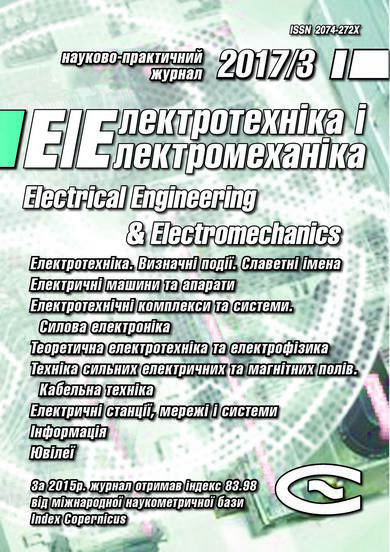MULTIFREQUENCY ALGORITHMS FOR DETERMINING THE MOISTURE CONTENT OF LIQUID EMULSIONS BY THE METHOD OF RESONANCE DIELCOMETRY
DOI:
https://doi.org/10.20998/2074-272X.2017.3.06Keywords:
moisture, method of resonance dielcometry, varietal uncertainty, mathematical model of emulsion, multifrequency algorithm, generalized metrological characteristicsAbstract
Purpose. The main attention is paid to the development and investigation of multifrequency algorithms for the realization of the method of resonance dielcometric measurement of the humidity of emulsions of the type «nonpolar liquid dielectric-water». Multifrequency algorithms take into account the problem of «uncertainty of varieties» and increase the sensitivity of the dielcometric method. Methodology. Multifrequency algorithms are proposed to solve the problem of «uncertainty of varieties» and improve the metrological characteristics of the resonance dielcometric method. The essence of the algorithms is to use a mathematical model of the emulsion and to determine the permittivity of the dehydrated liquid and the emulsion. The task of developing algorithms is to determine and take into account the influence of the parasitic electrical capacitance of the measuring oscillator and the measuring transducer. The essence of the method consists in alternately determining the resonance frequency of the oscillatory circuit with various configurations, which allows to take into account errors from parasitic parameters. The problem of «uncertainty of varieties» is formulated and solved. The metrological characteristics of the resonance dielcometric method are determined using algorithms. Results. Frequency domains of application of mathematical model of an emulsion are defined. An algorithm in a general form with four frequencies suitable for practical implementation in dielcometric resonance measurements is developed. Partial algorithms with three and two frequencies are developed. The systematic values of simulation errors in the emulsion in the microwave range are determined. Generalized metrological characteristics are obtained. The ways of increasing the sensitivity of the dielcometric method are determined. The problem of «uncertainty of varieties» was solved. Experimental data on determination of humidity for the developed algorithms are obtained. The value of the volumetric moisture in the transformer oil was measured. Originality. New multifrequency algorithms for determining the moisture content by the resonance dielcometric method have been proposed, investigated and practically realized. A generalized metrological characteristic for an algorithm with four frequencies is obtained. Metrological characteristics of algorithms for three and two frequencies are obtained. The problem of «uncertainty of varieties» was solved. Recommendations for increasing the sensitivity of dielcometric resonance moisture meters are developed and implemented. Practical value. The results of this work allow to solve the problem of «variability of varieties», increase sensitivity and accurately determine the moisture content in most nonpolar liquid dielectrics to a value of 10-5. This is applicable in a large field of electrical engineering, machine building, oil refining and the chemical industry.References
1. Golub E.Yu. Metody i sredstva povyshenija tochnosti diel'kometricheskih vlagomerov. Diss. cand. techn. nauk [Methods and means of increasing the accuracy of dielectric metric moisture meters. Cand. tech. sci. diss.]. Kharkov, 2016. 199 p. (Rus).
2. Zabolotnyy A.V. Technical realization of additive tests in a capacitive primary converter of the diesel-electric moisture meter of petroleum products. Measuring and Computing Devices in Technological Processes, 2013, no.3, pp. 49-53. (Rus).
3. Marcel L. Mounge. Method and apparatus for measuring and calculating bulk water in crude oil. Patent USA, no.4916940, 1990.
4. Zabolotnyy O.V. Sposib vymiryuvannya volohosti materialiv [The method of measuring moisture content]. Patent UA, no.201201992, 2014. (Ukr).
5. Platon G., Ramm C., Lohr K. Capacitive moisture sensor. Patent USA, no.7129713, 2006.
6. Suslin M. A. Mikrovolnovyy kontrol' aviatsionnykh GSM s ispol'zovaniyem radiotekhnicheskikh metodov rascheta tsepey s raspredelennymi parametrami [Microwave monitoring of aviation fuel and lubricants using radio engineering methods for computing circuits with distributed parameters]. Moscow, Mashinostroenie Publ., 2006. 120 p. (Rus).
7. Rudakov V.V., Korobko A.I., Korobko A.A. Electrophysical model of behavior emulsion mineral oil – water engineering type. Bulletin of NTU «KhPI», 2009, no.39, pp. 158-161. (Rus).
8. Hippel A.R. Dielektriki i ikh primeneniye [Dielectrics and their application]. Moscow, Gosenergoizdat Publ., 1953. 336 p. (Rus).
9. Rudakov V.V., Korobko A.A. Increasing the sensitivity of the moisture content measurements in transformer oil dielcometric method in resonant mode. Bulletin of NTU «KhPI», 2014, no.50(1092), pp. 143-149. (Rus).
10. Rudakov V.V., Korobko A.A. A high sensitive microwave measuring device of the moisture content in the non-polar dielectric liquids based on an inhomogeneous step coaxial resonator. Electrical engineering & electromechanics, 2016, no.5, pp. 51-56. (Rus). doi: 10.20998/2074-272X.2016.5.08.
Downloads
Published
How to Cite
Issue
Section
License
Copyright (c) 2017 A. A. Korobko

This work is licensed under a Creative Commons Attribution-NonCommercial 4.0 International License.
Authors who publish with this journal agree to the following terms:
1. Authors retain copyright and grant the journal right of first publication with the work simultaneously licensed under a Creative Commons Attribution License that allows others to share the work with an acknowledgement of the work's authorship and initial publication in this journal.
2. Authors are able to enter into separate, additional contractual arrangements for the non-exclusive distribution of the journal's published version of the work (e.g., post it to an institutional repository or publish it in a book), with an acknowledgement of its initial publication in this journal.
3. Authors are permitted and encouraged to post their work online (e.g., in institutional repositories or on their website) prior to and during the submission process, as it can lead to productive exchanges, as well as earlier and greater citation of published work.





